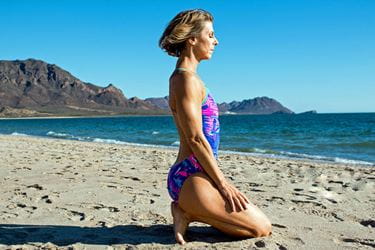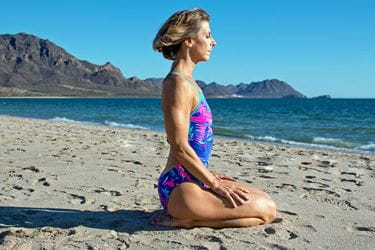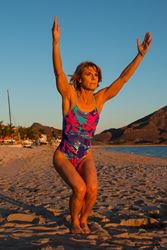Three Yoga Poses for a Better Kick
These poses will improve your ankle flexibility
Ankle flexibility is key to a strong, efficient kick, no matter what stroke you specialize in. Many yoga postures, or asanas, can improve ankle flexibility and stretch your calf (gastrocnemius and soleus) and shin (tibialis) muscles.
Breath, or pranayama, is the most vital component of yoga and should always lead the way when moving into and sustaining the postures. Breathe long and slow and smooth, feeling expansion in your abdomen, rib cage, and chest. Notice the subtleties of your breath. Taking deep breaths will help you become more aware of breath quality and how an expanded heart center and proper alignment enable you to take longer, more restorative breaths.
The toe squat, hero pose (virasana), and chair pose (utkatasana) all will stretch your calf and shin muscles and improve your ankle flexibility, if you practice them on a regular basis. For best results, perform these asanas after a series of sun salutations or a bout of aerobic activity when your muscles are warm and flexible.
The “no pain, no gain” philosophy should be discarded when practicing yoga. Muscle lengthening and a burn in the working muscles is normal, but you shouldn’t feel pain in your knees, ankles, hips, or other joints. Move into a comfortable expression of the pose and then remain there for five to 10 slow breaths.
Toe Squat
Benefits
The toe squat will stretch the quadriceps and the plantar fascia muscles on the bottom of your feet. The toe squat is an ideal pose for breaststrokers  to improve their ability to dorsiflex (draw their feet toward their shins), so they can catch more water with their feet. Triathletes and cyclists can ease plantar fascia discomfort with this pose. The toe squat also stimulates lower body meridians, which originate in the toes, and applies pressure to reflexology points in your toes and the balls of your feet. Avoid the toe squat if you have a knee injury or have had a knee or hip replacement.
to improve their ability to dorsiflex (draw their feet toward their shins), so they can catch more water with their feet. Triathletes and cyclists can ease plantar fascia discomfort with this pose. The toe squat also stimulates lower body meridians, which originate in the toes, and applies pressure to reflexology points in your toes and the balls of your feet. Avoid the toe squat if you have a knee injury or have had a knee or hip replacement.
How to Execute
Start on your hands and knees in the tabletop pose. Place a folded blanket under your knees for comfort if desired. Tuck all 10 toes under and then slowly start to walk your hands in toward your knees. The stretch felt in the full expression of the pose can be very intense.
The first time you try the toe squat, place a folded blanket or block behind your thighs to separate them from your heels or avoid sitting all the way back. Take a couple of deep breaths and see how you’re feeling. Once you can judge how your muscles are responding to this stretch, you can make a mindful decision about whether to advance any further.
To go into the full pose, walk your hands back until your buttocks are resting on your heels and then slowly stack your torso over your hips and keep your spine long. Place your hands on your thighs. Try to keep your heels positioned directly over your toes rather than allowing them to fall out to your sides. Take five to 10 deep breaths and make sure you relax your jaw and shoulders, which tend to tense up when a pose is new or uncomfortable. Come up out of the pose very slowly. Transitioning to the hero pose will provide a natural counterbalance in ankle movement.
Hero Pose (Virasana)
Benefits
Hero pose stretches your quadriceps and improves mobility of your ankle and knee joints. Practicing virasana on a regular basis will improve your flutter and dolphin kicks. It will also improve flexibility of your quadriceps and alleviate knee stiffness that may interfere with your ability to do a strong breaststroke kick. Avoid the hero pose if you have a knee injury or have had a knee or hip replacement.
improve flexibility of your quadriceps and alleviate knee stiffness that may interfere with your ability to do a strong breaststroke kick. Avoid the hero pose if you have a knee injury or have had a knee or hip replacement.
How to Execute
Start on your hands and knees with your hands shoulder-width apart and knees hip-width apart. Place the tops of your feet on the floor and slowly walk your hands in toward your knees, shifting your weight back until you are sitting on your heels. Keep your feet active, preventing supination of the ankles, to minimize torque on your knee.
If the stretch in your quadriceps is too intense or you feel discomfort in your knees or ankles, place a blanket or block between the backs of your thighs and your calves. You can also cushion your feet with a blanket if you feel too much pressure. Sit up tall, resting your hands on your thighs with relaxed shoulders and stay in the pose for five to 10 long, slow breaths.
Chair (Utkatasana)
Benefits
Utkatasana is the Sanskrit name for this pose. Although “fierce pose” is the translation into English, this asana is often referred to as chair pose because a person holding the posture sits back as if he or she is in a chair. The beauty of this asana is that it develops both strength and flexibility.
sits back as if he or she is in a chair. The beauty of this asana is that it develops both strength and flexibility.
Many people who have difficulty squatting have inflexible ankles or tight calf muscles. Performing the chair pose on a regular basis can improve the ability to dorsiflex your feet, which is beneficial for improving the power of a breaststroke kick and also for establishing good balance and stability for starts, performing squats, and walking up and down stairs. In the upper body, chest and side-body muscles are lengthened. In the lower body, the quadriceps, hamstrings, glutes, and even feet are strengthened.
How to Execute
Start in mountain pose with your feet touching or slightly apart, toes tracking straight ahead. Lift and spread your toes. Once you feel rooted to the ground on all four corners of both feet, slowly sit back as if there’s an invisible chair behind you, bringing your thighs as close to parallel to the floor as possible. Raise your arms up, palms facing in, and roll your shoulders down and away from your ears. Keep your weight concentrated in your heels and knees, tracking over your toes. Your toes should still be visible in front of your knees. Use your hamstrings to draw your sitting bones forward. This will keep you from arching your back. Stay in this posture for five to 10 breaths.
Categories:
- Technique and Training














